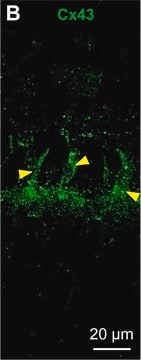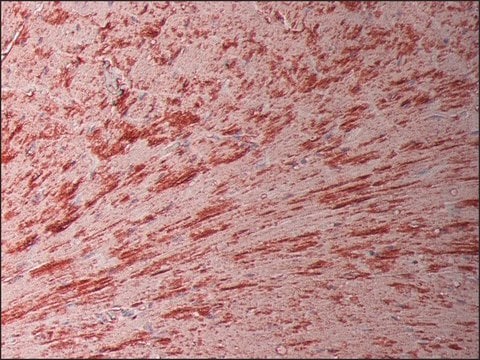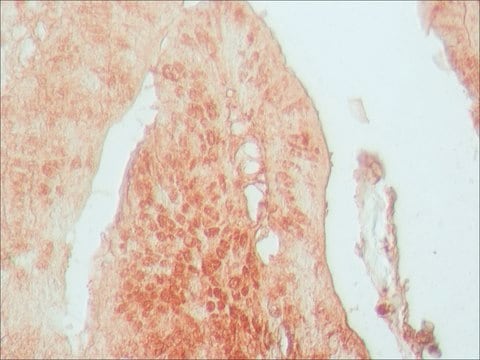Kluczowe dokumenty
C8093
Anti-Connexin 43 Antibody
mouse monoclonal, CXN-6
Synonim(y):
Mysie przeciwciało monoklonalne
Wybierz wielkość
3210,00 zł
Wybierz wielkość
About This Item
3210,00 zł
Polecane produkty
Nazwa produktu
Monoclonal Anti-Connexin-43 antibody produced in mouse, clone CXN-6, ascites fluid
pochodzenie biologiczne
mouse
białko sprzężone
unconjugated
forma przeciwciała
ascites fluid
rodzaj przeciwciała
primary antibodies
klon
CXN-6, monoclonal
masa cząsteczkowa
antigen 43 kDa
zawiera
15 mM sodium azide
reaktywność gatunkowa
rat, hamster, bovine, mouse, human
metody
immunocytochemistry: suitable
immunohistochemistry (formalin-fixed, paraffin-embedded sections): suitable
immunohistochemistry (frozen sections): suitable
indirect ELISA: suitable
microarray: suitable
western blot: 1:8,000-1:16.000 using mouse whole brain extract
izotyp
IgM
numer dostępu UniProt
Warunki transportu
dry ice
temp. przechowywania
−20°C
docelowa modyfikacja potranslacyjna
unmodified
informacje o genach
human ... GJA1(2697) , GJA1P1(2698)
mouse ... Gja1(14609)
rat ... Gja1(24392)
Opis ogólny
Specyficzność
Immunogen
Zastosowanie
- fluorescent immunostaining
- western blotting
- immunocytochemistry
- preparation of immuno-affinity columns
Działania biochem./fizjol.
Oświadczenie o zrzeczeniu się odpowiedzialności
Nie możesz znaleźć właściwego produktu?
Wypróbuj nasz Narzędzie selektora produktów.
polecane
Kod klasy składowania
13 - Non Combustible Solids
Klasa zagrożenia wodnego (WGK)
WGK 1
Temperatura zapłonu (°F)
Not applicable
Temperatura zapłonu (°C)
Not applicable
Wybierz jedną z najnowszych wersji:
Certyfikaty analizy (CoA)
Nie widzisz odpowiedniej wersji?
Jeśli potrzebujesz konkretnej wersji, możesz wyszukać konkretny certyfikat według numeru partii lub serii.
Masz już ten produkt?
Dokumenty związane z niedawno zakupionymi produktami zostały zamieszczone w Bibliotece dokumentów.
Produkty
Cancer research has revealed that the classical model of carcinogenesis, a three step process consisting of initiation, promotion, and progression, is not complete.
Active Filters
Nasz zespół naukowców ma doświadczenie we wszystkich obszarach badań, w tym w naukach przyrodniczych, materiałoznawstwie, syntezie chemicznej, chromatografii, analityce i wielu innych dziedzinach.
Skontaktuj się z zespołem ds. pomocy technicznej








